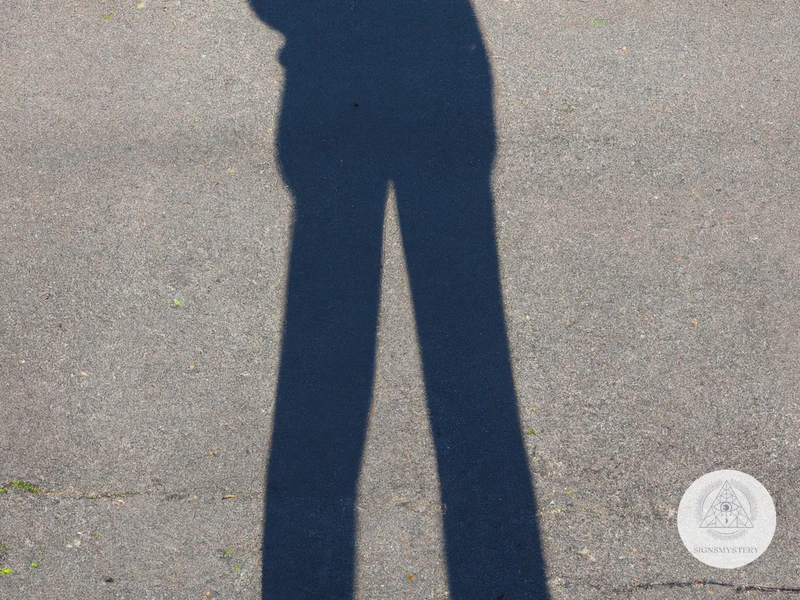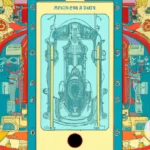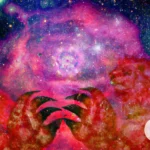As we journey through life, we often encounter aspects of ourselves that we’d rather keep hidden or ignore. These parts of ourselves, known as the Shadow Self, can manifest in negative behaviors, emotions, and beliefs that hinder our personal growth and relationships. But what exactly is the Shadow Self, and how can we integrate and heal from it? In this article, we’ll explore the origins and definitions of the Shadow Self in both tarot and Jungian psychology, as well as techniques for recognizing and working with it. By using tarot as a tool for self-reflection and understanding, we can delve deeper into our psyche and emerge stronger, more integrated individuals.
The Shadow Self: Definition and Origins

The exploration of the shadow self is an essential aspect of personal growth and self-discovery. It is a term coined by the famous psychologist Carl Jung, who believed that the human psyche comprises not only the conscious mind but also the unconscious mind. In this section, we will delve deeper into the definition and origins of the shadow self, examining its meaning in both Tarot and Jungian psychology. Understanding the shadow self can provide valuable insights into our deeper selves, allowing us to connect on a fundamental level with the Tarot’s archetypes and the collective unconscious. To learn more about tarot archetypes in Jungian psychology, follow this link.
In Tarot
The concept of the Shadow Self is often explored in Tarot readings and interpretations. The Shadow Self in Tarot is portrayed as the darker aspects of our psyche, the parts we often try to suppress or ignore. These suppressed feelings, thoughts, and actions can show up in the form of the tarot cards we draw. By facing and acknowledging these aspects of ourselves, we can work towards understanding and integrating them into our lives.
In Tarot, the Shadow Self is often connected to the concept of the collective unconscious. The idea of the collective unconscious was developed by Swiss psychoanalyst Carl Jung. Jung believed that the collective unconscious was comprised of universal archetypes and symbols that were shared among all humans. These archetypes and symbols were thought to be the building blocks of the psyche and could be seen throughout various cultures and mythologies.
In the context of Tarot, the collective unconscious is thought to manifest through the archetypal imagery and symbolism found within the cards. When we draw a card that triggers a negative emotional reaction, such as fear or anger, it may be a representation of a suppressed aspect of our Shadow Self that we have yet to confront.
Furthermore, Tarot can be used as a tool for self-discovery and exploration of the Shadow Self in the Jungian tradition. Through the interpretation of the cards, we can gain insight into our unconscious patterns and tendencies. This insight can be used to recognize and confront the aspects of our Shadow Self that we may be hesitant to acknowledge.
By understanding and integrating our Shadow Self, we can work towards a more balanced and integrated psyche. Tarot readings can provide a safe space for exploring and confronting these darker aspects of ourselves, bringing them to the surface and providing an opportunity for healing and growth.
Carl Jung’s connection to Tarot card readings and his theories on the psyche influenced how the Shadow Self is explored through tarot, making it a powerful tool for personal growth and self-discovery.
In Jungian Psychology
In Jungian Psychology, the Shadow Self is a concept created by Carl Jung to describe the unconscious part of the psyche that is composed of repressed feelings, instincts, and impulses. The Shadow Self contains all of the parts of ourselves that we deny or suppress, such as our fears, anger, and desires. According to Jung, these parts of ourselves are often considered unacceptable or unsavory by society and may lead to feelings of shame or guilt.
Jung believed that the Shadow Self is an essential part of the psyche that requires integration in order for a person to achieve individuation, which is the process of becoming a whole and integrated person. By bringing the Shadow Self into consciousness, a person can begin to recognize and work through their inner conflicts and better understand their true self.
Jung also believed that the Shadow Self is not only a personal aspect of the psyche but also a collective one that is shared by all humans. He theorized that the collective unconscious is made up of universal, archetypal symbols and motifs that are present in all cultures and societies. These archetypes can manifest in dreams, myths, and religious traditions, and are often represented in artistic mediums such as the tarot.
The tarot can be a powerful tool for exploring the Shadow Self in Jungian psychology because it contains archetypal images that are present in the collective unconscious. Tarot cards can be used to uncover repressed emotions and help a person gain insight into their unconscious motivations and desires. By using the tarot to explore the Shadow Self, a person can begin the journey of integration and self-discovery.
Sources:
- https://labyrinthos.co/blogs/tarot-card-meanings-list/self-discovery-jungian
- https://tolovewithin.com/tarot-and-jungian-psychology/
The Shadow Self in Tarot
Exploring the Shadow Self in tarot is a fascinating topic that delves deep into the human psyche. The tarot, as a tool for divination and self-reflection, has been used by many to explore the unconscious mind and its mysteries. The Shadow Self, as a concept, has been prevalent in both tarot and Jungian psychology. In fact, the tarot is often seen as a reflection of the collective unconscious, a concept introduced by Jung. In this section, we will delve into the different ways the Shadow Self manifests in tarot, both in the Major and Minor Arcana. For more on the connection between numerology and tarot, check out our article on numerology and tarot.
The Major Arcana
The Major Arcana consists of 22 cards that are often seen as the core of the Tarot deck. Each card represents a significant lesson or theme and can even be seen as a journey through life. When exploring the Shadow Self, several Major Arcana cards can provide insight and guidance.
The Devil: This card often represents unhealthy habits, addictions, and negative thought patterns that keep us trapped and feeling powerless. It’s a reminder that we have the power to break free from these patterns and take control of our lives.
The Tower: The Tower card can be a challenging one to face as it represents sudden upheaval and destruction. However, it’s important to remember that out of destruction can come growth and new beginnings.
Death: This card is often feared but can represent positive change and transformation. It’s a reminder that endings are a natural part of life and can lead to new beginnings.
The Hanged Man: This card can represent a state of limbo or feeling stuck, but it’s also an invitation to surrender and let go of control. Sometimes, in order to move forward, we must first release our attachment to certain outcomes.
The Judgement: This card represents a call to action and a wake-up call to make necessary changes in our lives. It’s a reminder to listen to our intuition and inner voice.
By exploring these cards and their meanings, we can gain a deeper understanding of our own Shadow Selves and begin to work towards healing and integration. The Tarot can be a powerful tool for accessing our subconscious and uncovering hidden truths about ourselves and our lives.
For more information on the connection between Tarot and Jungian psychology, check out our article on Tarot and the Collective Unconscious.
The Minor Arcana
The Minor Arcana consists of four suits: Swords, Wands, Cups, and Pentacles. Each suit represents a different aspect of life and human experience. Traditionally, the Swords suit represents conflict, the Wands suit represents creativity and ambition, the Cups suit represents emotions and relationships, and the Pentacles suit represents material possessions and wealth.
In relation to the Shadow Self, each suit can offer unique insights and challenges:
| Suit | Potential Shadow Issues | Potential Healing Messages |
|---|---|---|
| Swords | Overthinking, anxiety, fear, self-doubt. | Learn to trust your intuition, speak up for yourself, release negative thoughts and beliefs. |
| Wands | Arrogance, overconfidence, recklessness, burnout. | Find balance between ambition and self-care, stay rooted in your values and ethics, work collaboratively with others. |
| Cups | Codependency, emotional suppression, addiction, unhealthy relationships. | Practice self-love and self-compassion, set boundaries, express emotions in healthy ways, cultivate authentic connections with others. |
| Pentacles | Greed, materialism, financial stress, lack of purpose. | Tap into your creativity and abundance mindset, focus on what truly matters in life, give back to your community. |
Exploring the Minor Arcana through a Shadow work lens can deepen your understanding of yourself and your patterns of behavior. Using the Tarot as a catalyst for self-reflection can lead to profound insights and transformation.
Integration and Healing
As we explore the concept of the shadow self in both tarot and Jungian psychology, we begin to understand the deep, often subconscious aspects of ourselves that we hide from the world. Integrating and healing these aspects can be a daunting task, but it is crucial for our personal growth and wellbeing. Within this section, we will delve into various techniques for recognizing and working with the shadow self, both in and out of tarot practice. These methods can assist in the process of integration and ultimately lead us towards a more complete and fulfilled existence.
Recognizing Your Shadow Self
Recognizing Your Shadow Self
Recognizing your shadow self can be a complex and challenging task, as it involves becoming aware of aspects of yourself that you may have been unconsciously repressing or denying. However, it is an essential step towards greater self-awareness and personal growth. Here are some ways to begin recognizing your shadow self:
| Pay attention to your emotional reactions | Notice any strong emotional reactions that you may have towards others. These reactions may be triggered by qualities that you repress within yourself. |
|---|---|
| Reflect on your dreams | Pay attention to the themes and symbols in your dreams, as they often contain insights into your unconscious mind, includingSubscribe to Our NewsletterSign up to receive the latest news and updates. |
| Be mindful of your projections | Notice when you attribute certain qualities, both positive and negative, to others. These qualities may actually be a reflection of your own disowned parts. |
| Explore your creative expression | Consider engaging in creative activities, like writing or art, which can help you access and express your unconscious mind. |
By engaging in these practices, you can begin to shed light on the parts of yourself that may have been hidden in the shadows. Remember, recognizing your shadow self is only the first step towards integration and healing.
Shadow Work Techniques
One of the primary goals of exploring the Shadow Self is to understand the hidden aspects of ourselves and integrate them into our conscious awareness. This process is known as Shadow Work, and there are several techniques that can be used to facilitate this transformational journey.
| Technique | Description |
|---|---|
| Journaling | Writing down your thoughts and feelings on a regular basis can help you identify patterns in your behavior and thoughts. It can also serve as a tool for reflecting on your Shadow Self. |
| Meditation | Through meditation, you can engage in introspection and self-reflection to gain insight into your subconscious. This can help you identify and transform Shadow aspects of yourself. |
| Art Therapy | Creating art can be a therapeutic way to express and explore your Shadow Self. By visualizing your inner world, you can gain clarity and insight into hidden aspects of yourself. |
| Bodywork | Working with the body can be a powerful way to release stored emotions and trauma. Practices like yoga, dance, or somatic therapy can facilitate the integration of Shadow aspects into your conscious awareness. |
| Psychotherapy | Working with a qualified therapist can provide a safe and supportive space to explore your Shadow Self. Therapists can employ a variety of techniques to help you integrate and transform Shadow aspects of yourself. |
Ultimately, the most effective technique for Shadow Work will vary from person to person. It is important to experiment with different approaches and find what resonates with you. The key is to approach the process with a sense of openness, curiosity, and a willingness to confront your deepest fears and desires.
Using Tarot for Shadow Work
Tarot cards can be a powerful tool for exploring and understanding the shadow self. Here are some ways to use tarot cards for shadow work:
1. Pull cards for introspection: Start by pulling a tarot card or a spread of cards to gain insight into your shadow self. Focus your question on what aspects of your shadow self are in need of attention.
2. Identify shadow archetypes: Learn the shadow archetypes and identify which ones you resonate with the most. Use tarot cards to help you recognize how these archetypes play out in your life.
3. Use the tarot for reflection: Look at the symbolism within tarot cards to gain insight into your own darkness. For example, The Tower card can represent a breakdown or upheaval, which may be a reflection of your own shadow self.
4. Explore reversed meanings: Reversed tarot cards can indicate shadow aspects that you are repressing or avoiding. Use reversals as an opportunity to explore what you may be hiding from yourself.
5. Use tarot to track progress: As you do your shadow work, use tarot cards to track your progress. Pulling the same card twice may indicate that you still have work to do, or that progress has been made in this area.
6. Seek guidance from tarot readers: If you are struggling to understand your shadow self or how to integrate it into your life, seek guidance from a tarot reader. They can help you gain insight into your situation and offer advice on how to move forward.
Remember, the tarot is just a tool to help you gain insight into your shadow self. It is up to you to do the work and integrate these aspects into your life. Trust the process and be patient with yourself as you navigate this journey.
Closing Thoughts
After exploring the concept of the shadow self in both Tarot and Jungian psychology, it becomes apparent that facing and integrating our shadow is crucial for personal growth and spiritual evolution. The shadow self contains aspects of ourselves that we have repressed, denied, or deemed unacceptable, and integrating these parts can lead to a deeper understanding and acceptance of ourselves.
One of the most valuable tools for exploring the shadow self is Tarot, which can help us uncover hidden aspects of ourselves and bring them to the surface for examination. However, it is important to approach this work with caution and respect, as delving into the shadow can be a challenging and emotionally taxing process.
Through recognizing and working with our shadow selves, we can begin to heal past wounds and self-limiting beliefs, and develop a greater sense of wholeness and inner peace. This work requires a deep commitment to understanding and embracing all aspects of ourselves, both light and dark.
In the end, exploring the shadow self is a necessary and transformative journey that ultimately leads to greater self-awareness and personal evolution. May we all have the courage and compassion to face our shadows and integrate them in a way that allows us to shine our brightest light.
Frequently Asked Questions
What is the Shadow Self?
The Shadow Self is the unconscious part of our psyche that contains negative qualities and traits that we deny or repress about ourselves.
How does the Shadow Self originate?
The Shadow Self is formed in childhood when we learn what is acceptable and unacceptable in our society and within our family systems. We push aside parts of ourselves that don’t align with these societal norms.
What is the importance of exploring the Shadow Self?
Exploring the Shadow Self can lead to a deeper understanding of ourselves and help us integrate our negative qualities in a healthy way.
What is Tarot?
Tarot is a deck of 78 cards that are used for divination, self-discovery, and guidance.
How does Tarot relate to the Shadow Self?
Tarot can be used as a tool for exploring the Shadow Self, as many of the cards represent archetypes and aspects of the psyche.
What is Jungian Psychology?
Jungian Psychology is a branch of psychology that focuses on the unconscious psyche and the process of individuation.
How does Jungian Psychology relate to the Shadow Self?
Jungian Psychology places a strong emphasis on the Shadow Self and its importance in psychological development and individuation.
What are some techniques for recognizing the Shadow Self?
Dream analysis, journaling, and exploring our triggers and projections can help us recognize our Shadow Self.
What is shadow work?
Shadow work is the process of exploring and integrating our Shadow Self, often with the help of a therapist or other healing practitioner.
How can Tarot be used for shadow work?
Tarot can provide insight, guidance, and reflection as we explore our Shadow Self and work to integrate its qualities into our consciousness.










